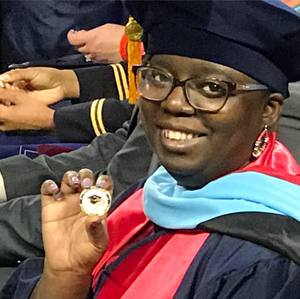Dr. LaConti Bryant @LaContiBryant
Breaks Down Her Ground-Breaking Study:
The System for Teacher and Student Advancement and Embedded
Professional Development: A Case Study
 @LaContiBryant
@LaContiBryant
This study examined The System for Teacher and Student Advancement (TSTSA), formerly known as The Teacher Advancement Program (TAP), and the perceptions of educators that were a part of the job-embedded professional development process in various roles over a minimum of 5 years of implementation.
Unfortunately, a lot of research is focused on traditional professional and teacher development. There has been minimal research examining models of job-embedded professional development that has had an impact on both students and teachers. Both, No Child Behind and The Every Student Succeeds Acts, stipulate that professional development as an interactive, constructive process that is tied to what teachers are doing in the classroom on a daily basis. It is not a conference, workshop, or “sit and get” activity. However, effective professional development is a systematic process that is driven and created based on student data and instructional best practices.
The System for Teacher and Student Advancement is considered a reform model for providing innovative job-embedded professional development for teachers. It consists of four different components: (a) multiple career paths, (b) instructionally focused accountability, (c) ongoing, and applied professional growth, and (d) performance based compensation. For this study I interviewed seven professional educators that were in the roles of career teachers, mentor teachers, and master teachers about their perceptions regarding the professional development component of this process, as well as, how collaboration and instructional practices were impacted. Of the seven participants, six were female and one was male. Three were career teachers, one was a mentor teacher, and three were master teachers. When examining each teacher’s perception of this process, the overarching theme that emerged was the focus on relationships through collaboration and effective embedded instructional coaching and mentoring. Through improving relationships with teachers across content areas and grade levels, teachers were able to (1) communicate their instructional needs, which in turn impacted student achievement and (2) deal with the challenges of implementing and sustaining job-embedded professional development.
The findings indicated that TSTSA’s job-embedded professional development component help to booster collaboration and positive relationship amongst teachers with the continued focus on student achievement. Additionally, collaboration improved over time because of the framework and structure that TSTSA’s clusters (embedded professional learning communities) provided. Finally, embedded coaching support that was provided along with collaboration fostered positive relationship building across grade levels.
Dr. LaConti Bryant earned her Ed.D in Educational Leadership from Liberty University in 2017. Her research is specifically focused on the areas of instructional coaching/mentoring, collaboration, and job-embedded professional development. Dr. Bryant has worked with teachers and administrators with creating professional learning communities that are conducive to positive results in student achievement and teacher development. In addition, Dr. Bryant has over 10 years of classroom experience as a classroom teacher and instructional coach. Prior to entering public education, Dr. Bryant served in the United States Army as a paralegal for 5 years stationed at Fort Campbell, Kentucky, Bamberg, Germany, and Fort Hood, Texas.
Unfortunately, a lot of research is focused on traditional professional and teacher development. There has been minimal research examining models of job-embedded professional development that has had an impact on both students and teachers. Both, No Child Behind and The Every Student Succeeds Acts, stipulate that professional development as an interactive, constructive process that is tied to what teachers are doing in the classroom on a daily basis. It is not a conference, workshop, or “sit and get” activity. However, effective professional development is a systematic process that is driven and created based on student data and instructional best practices.
The System for Teacher and Student Advancement is considered a reform model for providing innovative job-embedded professional development for teachers. It consists of four different components: (a) multiple career paths, (b) instructionally focused accountability, (c) ongoing, and applied professional growth, and (d) performance based compensation. For this study I interviewed seven professional educators that were in the roles of career teachers, mentor teachers, and master teachers about their perceptions regarding the professional development component of this process, as well as, how collaboration and instructional practices were impacted. Of the seven participants, six were female and one was male. Three were career teachers, one was a mentor teacher, and three were master teachers. When examining each teacher’s perception of this process, the overarching theme that emerged was the focus on relationships through collaboration and effective embedded instructional coaching and mentoring. Through improving relationships with teachers across content areas and grade levels, teachers were able to (1) communicate their instructional needs, which in turn impacted student achievement and (2) deal with the challenges of implementing and sustaining job-embedded professional development.
The findings indicated that TSTSA’s job-embedded professional development component help to booster collaboration and positive relationship amongst teachers with the continued focus on student achievement. Additionally, collaboration improved over time because of the framework and structure that TSTSA’s clusters (embedded professional learning communities) provided. Finally, embedded coaching support that was provided along with collaboration fostered positive relationship building across grade levels.
Dr. LaConti Bryant earned her Ed.D in Educational Leadership from Liberty University in 2017. Her research is specifically focused on the areas of instructional coaching/mentoring, collaboration, and job-embedded professional development. Dr. Bryant has worked with teachers and administrators with creating professional learning communities that are conducive to positive results in student achievement and teacher development. In addition, Dr. Bryant has over 10 years of classroom experience as a classroom teacher and instructional coach. Prior to entering public education, Dr. Bryant served in the United States Army as a paralegal for 5 years stationed at Fort Campbell, Kentucky, Bamberg, Germany, and Fort Hood, Texas.